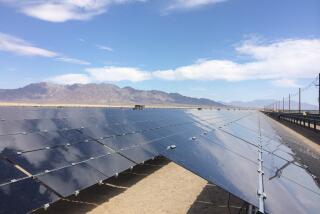Clean Air Act Will Fuel New Technologies
The new clean air legislation, which President Bush may sign before the end of this week, contains both costs and benefits--and a lot of possibilities that are not immediately evident. The trick in understanding the law is not to view it too narrowly.
The costs undoubtedly will be high. The total price tag to industry and consumers for dispelling smog, curbing acid rain and otherwise eliminating toxics from the air could run to $10 billion a year by 1995 and double that early in the next century when all the new regulations go into effect.
Electric utilities, especially in the Midwest, will have to change fuels and install even more anti-pollution equipment. The act could add 23% to some electric bills, says analyst Edward J. Tirello of Smith Barney, the investment firm.
Oil refiners will have to reformulate gasoline to eliminate some chemicals and to add others. That could add 10 to 15 cents a gallon to the price at the pump. And improvements to exhaust controls will cost more than $100 a car.
Implementing the clean air act may seem like a low blow to a limping economy. Because cost accounting doesn’t reflect social benefits, cleaner air will not show up as a productivity gain for the economy. The costs of anti-pollution equipment will either clip corporate bottom lines or be passed along to consumers in higher prices.
Big companies will be able to shoulder or pass on such costs, but small businesses could face a special burden, says Vice President David Souten of Systems Applications Inc., a Livermore, Calif., firm that supplies computer models to the Environmental Protection Agency.
Despite the costs, the law’s benefits will be significant. Air quality badly needs improving in America’s large cities, and in some not so large--Hartford, Conn., for example, or Baton Rouge, La. “The act deals with real problems. It will produce health benefits and reduce property damage from chemical emissions,” says Dale Jorgenson, a Harvard economics professor.
So, with good reason, the American public has decided that clean air is worth the money.
But that’s not all there is to say on the matter. The truth is, the clean air act properly understood is an economic force that will drive new technology, provide a push for business and increase U.S. competitiveness.
In the near term, the act will provide a big boost for investment in pollution-control equipment, says Grant Ferrier, editor of Environmental Business Journal. Sales of pollution equipment for power plants and factories will surpass $2 billion a year, and Combustion Engineering, Wheelabrator Technologies, Research Cottrell and others will benefit.
Makers of catalytic converters, such as Corning and Allied-Signal, will benefit as California’s stricter emission standards are imposed on the rest of the country. And the engineering firms--Fluor Corp., Parsons Co., Jacobs Engineering and others--will benefit as refineries are modified to produce new gasoline. Archer-Daniels-Midland will sell more ethanol to lend a higher oxygen mix to gasoline.
But beyond an obvious push for anti-pollution equipment, the new clean air act will have less predictable consequences--as previous legislation has had.
The first Clean Air Act in 1969 immediately shut down incinerators for burning garbage in the United States. They were replaced by landfills, which went beyond the standards of the old city dump to become technological waste-treatment facilities. Now landfills are yielding to incinerators again, but with far more complex environmental standards.
The upshot of that has been not only an improvement in public health but a whole new industry, now approaching $60 billion in annual revenue and about to take off.
“Public policy has always spurred our industry,” says Harold Gershowitz, senior vice president of Waste Management Inc., the Chicago-based world leader in waste disposal at $5 billion in revenue. Regulations have raised standards and forced technological improvements in waste treatment. And that has produced a competitive advantage for U.S. companies.
It’s an instructive pattern. Europe, building from scratch after World War II, first developed superior waste disposal methods. Then, when the Clean Air Act of 1969 hit, U.S. companies licensed the European technologies. But pushed by U.S. regulations, they went beyond Europe’s standards. Now companies such as Waste Management are preparing to export that improved technology back to the Continent.
“European unification in 1992 will mean higher waste-treatment standards for many countries and a big demand for U.S. technology,” says Gershowitz. That’s not to mention the awesome environmental task opening up in Eastern Europe.
And the new clean air act may go even further to promote technology and industry. Where previous environmental laws have mandated use of “best available” methods and equipment, the new act sets requirements and trusts that the needed technology will be developed.
Its implementation into the next decade may well yield the commercial development of electricity from wind or solar power and transportation from magnetically powered trains and non-polluting automobiles. It will make changes in the way we live.
And it should. A single statistic puts the issue in perspective: According to Dr. Kaye Kilburn of USC, youngsters growing up in Los Angeles suffer a 10% to 15% loss in lung function compared to children who live where the air is less polluted. Doing something about that is what public policy and good business are all about.
More to Read
Inside the business of entertainment
The Wide Shot brings you news, analysis and insights on everything from streaming wars to production — and what it all means for the future.
You may occasionally receive promotional content from the Los Angeles Times.










